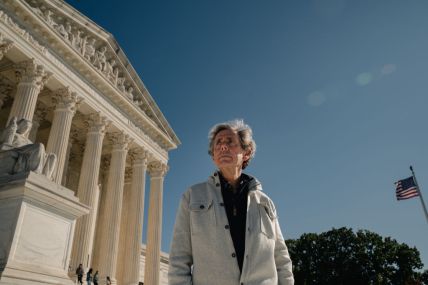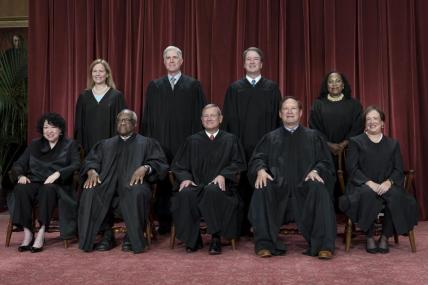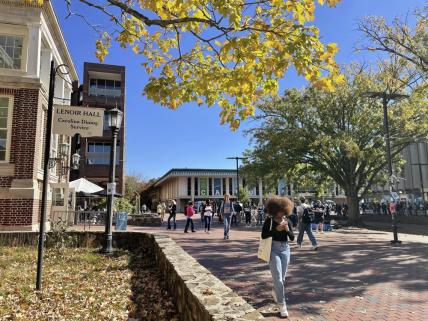A brief history of affirmative action…for white people
OPINION: As the Supreme Court hears arguments that will likely lead to the end of affirmative action, we thought we’d look at how America created a perpetual advantage for white people.

Editor’s note: The following article is an op-ed, and the views expressed are the author’s own. Read more opinions on theGrio.
On Monday, Supreme Court justices heard legal arguments in two cases that many experts say will signal the end of affirmative action.
The suits before the court involve race-based admissions policies at the University of North Carolina and Harvard. At every step of the process, lower courts have affirmed the schools’ right to curate their student body by considering the factual evidence of racial disparities. In two previous cases, America’s highest judicial authority has also conceded the constitutionality of race-based college admissions. But, as with the overturning of Roe v. Wade, the Supporters of a Caucasian, Oligarchal, Theocratic, Ultraconservative State (SCOTUS) no longer believe in the idea of legal precedence.
Both universities say that race is only “one factor in a host of individualized evaluations for admission without quotas,” reports Reuters. Meanwhile, the plaintiffs allege that affirmative action hurt white and Asian applicants with higher SAT scores and better grades. They don’t care that most Black and Hispanic students attend majority-nonwhite schools. They don’t care that Black students receive less funding, fewer advanced courses and harsher punishment than majority-white school districts. They want a true meritocracy that only considers the things they do well.
But don’t worry; affirmative action isn’t going anywhere.
Even if the SCOTUS ultimately decides to outlaw policies aimed at creating a level playing field, the policies and practices that benefit people who were born into this country’s most privileged racial group will continue to exist. It’s the American way.
Here is a brief history of the laws and practices that created affirmative action for white people.
1607: White Jesus Comes to America
While waiting for his government committee to finish his reboot of a 66-part series that became known as the King James Bible, England’s new monarch sent 104 missionaries to Turtle Island for the purpose of “propagating of Christian religion to…bring the infidels and salvages living in those parts to humane civilitie and to a setled and quiet govermente.” The First Charter of Virginia gave the white man the right to any territory “not now actually possessed by any Christian Prince or People.”
It did not go well.
After a period of starvation, cannibalism and government assistance from the indigenous nation, the royal government created a policy of granting headrights — 50 acres of stolen land to anyone who could bring over some help. In 1638, George Menefie realized that he could receive headrights for perpetually enslaved Africans. Two years later, the Massachusetts colony used Leviticus 26:39-46 to legalize slavery…but only for non-white Christians. “There shall never be any bond slaverie, villinage or captivitie amongst us unless it be lawfull captives taken in just warres, and such strangers as willingly selle themselves or are sold to us,” the affirmative action statute said.
These first recipients of affirmative action still retain much of their generational wealth.
1740: South Carolina Reinvents Slavery
After a literate enslaved African named Jemmy led a group of bondmen to emancipate themselves and kill every white man they laid eyes on, South Carolina passed the Negro Act of 1740. The legislation made it illegal for human chattel to write, gather in groups of two or “refuse to submit or undergo the examination of any white person.” The law also served as the basis for slave codes across the colonies and was later affirmed by at least 10 state supreme courts.
But the lasting impact of the law was that it codified white supremacy by classifying America’s race-based form of bondage under property law, successfully revoking the citizenship and the humanity of enslaved chattel for more than a century.
To many Americans, Black people are still regarded as things.
1776: Revolutionary Affirmative Action
Shortly after declaring that “all men are created equal,” the white patriots realized that they might have to fight for their freedom. Instead of risking their lives, these cowardly revolutionaries sent their enslaved chattel to take their place. The white soldiers who did fight received land bounties while the Black and Native soldiers in the 1st Rhode Island Regiment — America’s first integrated military unit — won the prize of living in an even more racist country.
1787: Black = White x .6
Twenty-five slave owners and 30 other white men created “white math” by signing a document valuing each enslaved human at 60 percent of a white man. Although Ron DeSantis and your social studies teacher insist that the founders hated slavery, the wig-wearing white boys unanimously agreed to Article I Section 9, which extended human trafficking for at least 20 years. America’s foundational document also transformed every single American citizen into an enslaver by binding them to the Fugitive Slave Clause. Still, when dumb people claim “slavery existed in every culture,” they’re kinda right.
Our foundational document created a uniquely American, nationwide, constitutionally enshrined, race-based form of perpetual legal subjugation that reduced human beings to chattel.
That’s the foundation of “American exceptionalism.”
We just call it “slavery.”
1790: Affirmative Action Immigration Law
The first Congress of the United States granted citizenship to “any alien, being a free white person” who has been in the United States for two years.
1830: The Trail of White Tears
Using manifest destiny — the idea that God wants white people to own the entire continent — the Indian Removal Act kicked indigenous landowners out of Georgia and handed the stolen land to white people using a lottery system.
While most of the people who lived on the stolen land were Native American, the 1835 Cherokee census counted 8,936 Cherokee, 776 enslaved Black people and 68 intermarried white people who eventually embarked on the Trail of Tears. However, when the American government attempted to repair the harm, the Cherokee Nation expelled their Black members while the multiracial white members got reparations.
1856: Supreme Whiteness
Even though the Dred Scott v. Sandford decision noted that Black people as “beings of an inferior order, and altogether unfit to associate with the white race, either in social or political relations; and so far inferior, that they had no rights which the white man was bound to respect,” it mostly affirmed whiteness.
“The word white is evidently used to exclude the African race,” wrote U.S. Supreme Court Chief Justice Roger Taney, who affirmed that the Constitution regards the “negro race as a separate class of persons.”
1862: 160 Acres and a Mule
When the U.S. government split 500 million acres into 160-acre plots for “any adult citizen, or intended citizen, who had never borne arms against the U.S. government,” the Homestead Act was intended to lift freedmen, immigrants and poor white people out of poverty.
Guess who didn’t get any of that land?
“Ultimately, 270 million acres, or 10% of the total land area of the United States, was converted to private hands, overwhelmingly white, under Homestead Act provisions,” explained PBS.
1865: The End of White Mass Incarceration
The South’s Antebellum prison system was primarily filled with white men and European immigrants. After the Civil War, states began enacting “Black Codes” that criminalized African Americans for vagrancy, unemployment and learning job skills without being approved by white people.
Not only would this plan result in a disproportionately nonwhite carceral system, but Black prisoners would also provide free labor for private companies and individuals who previously depended on enslaved Africans.
1877: Affirmative Insurrection
The Compromise of 1877 is usually taught as a “compromise to resolve the election impasse and address other outstanding issues” pertaining to the 1876 presidential election between Republican Rutherford B. Hayes and Democrat Samuel J. Tilden. Although it signaled the end of Reconstruction and the beginning of Jim Crow, it was also a terrorist plot that actually overthrew the U.S. government.
In 1876, Democrat Wade Hampton was running for governor of South Carolina — a majority-Black state. White supremacist “rifle clubs” engaged in a statewide terror campaign, most notably in Edgefield County. After “the leading white men of Edgefield” massacred Black voters to “answer the purpose of redeeming the state from negro and carpetbag rule,” they rigged the election. In Edgefield, Hampton won more votes than the total number of registered voters in the county. And when South Carolina refused to count Black votes in the presidential election, 15 white men went into a room and exchanged a Hayes victory in exchange for allowing states to disenfranchise and ignore the rights of Black citizens.
Hayes won the Electoral College by a single vote.
Ben “Pitchfork” Tillman, the leader of the Hamburg Massacre, was eventually elected governor. At his inauguration, he bragged that “I, as the exponent and leader of the revolution which brought about the change, am here to take the solemn oath of office … the triumph of democracy and white supremacy over mongrelism and anarchy, of civilization over barbarism, has been most complete.”
That’s not the affirmative action part.
For decades, any South Carolinian running for office as a “Tillmanite” that could prove they “fought in ’76” was almost guaranteed to be elected in the state.
1892: White But More Equal
Plessy v. Ferguson — the SCOTUS case known for the “separate but equal” doctrine — wasn’t racist. It was a form of affirmative action.
The court was trying to protect “the astute men of the dominant race,” who may be disturbed “that the integrity of the white race may be corrupted, or that its supremacy will be imperiled, by contact…with black people.
1898: Retroactive Affirmative Action
White Louisianans were tired.
By 1898, they had used violence, white leagues and bloodshed to ensure white rule in Colfax, Coushatta, New Orleans, Opelousas, and Thibodaux. Now they wanted to try something different.
Apparently, massacre-ing is very time-consuming.
On May 12, 1898, after white men regained political leadership from nontraitors, the former confederates adopted a state constitution that disenfranchised its Black citizenry using every conceivable method, including literacy tests, poll taxes and felony voting restrictions. While the constitution didn’t explicitly say “not Black people,” the document provided a loophole for the children and grandchildren of voters who cast ballots before slavery was abolished, which is why it became known as the “grandfather clause.”
In the closing session of the constitutional convention, judicial chair Thomas Semmes said: “We met here to establish the supremacy of the white race, and the white race constitutes the Democratic party of this State.”
1920: Affirmative Action for White Women
White women gained the right to vote when the 19th Amendment to the Constitution was ratified. White women eventually became the most powerful voting bloc in America, benefitting from white suffragists’ decision to intentionally exclude Black women from their movement.
1933: New Deal, Whites Only
President Franklin Roosevelt and Congress began enacting a series of programs, economic policies and public work programs called the “New Deal.” The legislative and executive acts helped lift millions of Americans out of the poverty caused by the Great Depression. The New Deal created a new economic tier called the “middle class.” However, Black Americans and immigrants were not included in many of these provisions.
Domestic workers and agriculture workers could not participate in Social Security. The Home Owners’ Loan Corporation created “redlining” maps that prevented people in Black neighborhoods from acquiring government-backed mortgages. The National Recovery Administration created a separate pay scale for Black workers and had a “whites first” hiring policy. Banks refused to loan money to Black farm owners while white farmers used government loans to evict sharecroppers from their land.
The New Deal didn’t just increase the racial wealth gap; it was a government-approved affirmative action plan.
1944: Soldiers Report a White Discharge
When lawmakers drafted a proposal to provide homes and education for veterans in 1944, they initially wanted to exclude the 1.2 million Black men who fought in World War II. Instead of doing it explicitly, they used the concept of “states’ rights” to ensure that the GI Bill would exclude as many Black veterans as possible. Because of segregation laws, Black soldiers could not buy homes in white neighborhoods or use their education benefits at white colleges. Redlining prevented them from getting loans for homes in white neighborhoods. But one of the biggest but rarely discussed obstacles for Black veterans was racism inside the U.S. military.
To qualify for the GI Bill, soldiers had to be honorably discharged. When the war ended in September 1945, white military officers suddenly started punishing Black soldiers for small infractions. Between August and November 1946, 39 percent of Black soldiers were dishonorably discharged from the Army, compared to 21 percent of white soldiers.
1954: White Privilege Schools
After the SCOTUS ended segregation with the Brown v. Board of Education ruling, state governments went on the offensive by organizing a resistance effort to keep their schools negro-free.
Virginia’s “Massive Resistance” policy was organized by the state legislature to block desegregation, preferring “the end of public education, rather than unsegregated schools.” The Mississippi Sovereignty Commission fought integration by investigating activists and civil rights workers who “challenged the racial status quo.” Alabama’s Board of Education outright refused to comply with the law.
Perhaps the birth of “segregation academies” was the biggest collective effort to maintain white supremacy in the education system. More than 750,000 white children enrolled in more than 3,000 inexpensive, all-white private schools. Many of these schools still exist — not just in the South, but across America.
Interestingly, many segregation academies are now considered “elite schools” with stellar academic reputations, including two of the five highest-ranked private schools in Alabama (Indian Springs and the Montgomery Academy), Mississippi (Jackson Academy and Jackson Preparatory School) and South Carolina (Hammond School and Hilton Head Prep).
1970: Drugs Are a Social Construct
On Oct. 27, 1970, President Richard Nixon signed the Comprehensive Drug Abuse Prevention and Control Act.
While it neither prevented nor controlled drug abuse, it created a class system for illicit drugs, making some more illegal than others. This same, unscientific rationale has been used to explain 100-to-1 crack vs. cocaine sentencing, racist policing practices and why Black people are disproportionately investigated, arrested and incarcerated for drugs despite white people using and selling drugs at higher rates.
But don’t take my word for it. Here’s what Nixon’s domestic policy adviser John Ehrlichman had to say about it:
We knew we couldn’t make it illegal to be either against the war or black, but by getting the public to associate the hippies with marijuana and blacks with heroin and then criminalizing both heavily, we could disrupt those communities. We could arrest their leaders, raid their homes, break up their meetings, and vilify them night after night on the evening news. Did we know we were lying about the drugs? Of course we did.
2022: White Tears
White people in America get more school funding, lower prison sentences, better pay, higher home values, more political representation, less punishment, lower interest rates, more jobs, better health care, and even more access to food. While these are examples of racism, none of those practices are necessarily attributable to affirmative action. Perhaps the biggest affirmative action policy in America is this:
White people get to cry.
Sure, Black people also get to cry. The difference is when a speckle of a teardrop forms in the corner of a white person’s eye, America will do something. When Black people complain about voter suppression, nothing happens. When white people create a myth of voter fraud, states will recount votes, file lawsuits and pass legislation. Black people have fought for police reform for more than a century, but every time a white person clutches their pearls, a police department gets a new officer. Black people have to fight for access to higher education while a whimper from a white mouth can make the oldest, richest institution or university in the country rethink equality.
No, that’s not white privilege or racism. Privilege is subjective and unquantifiable. Racism is negative and destructive. Affirmative action is a specific policy created to level the playing field for a certain group.
America is an affirmative action…
For whiteness.

Michael Harriot is a writer, cultural critic and championship-level Spades player. His book, Black AF History: The Unwhitewashed Story of America, will be released in 2022.
TheGrio is FREE on your TV via Apple TV, Amazon Fire, Roku, and Android TV. Please download theGrio mobile apps today!



